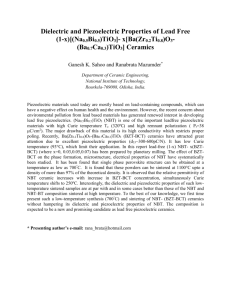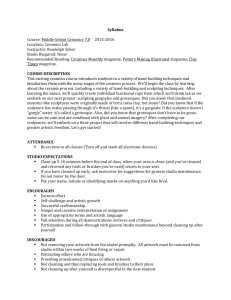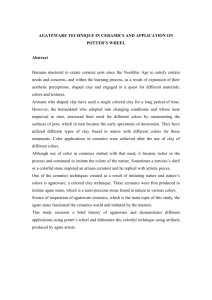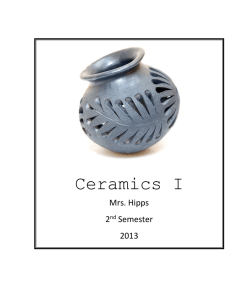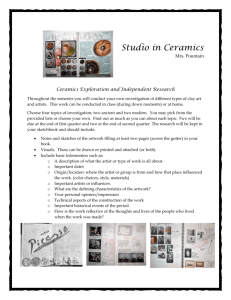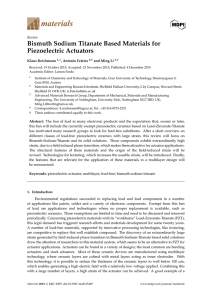View
advertisement
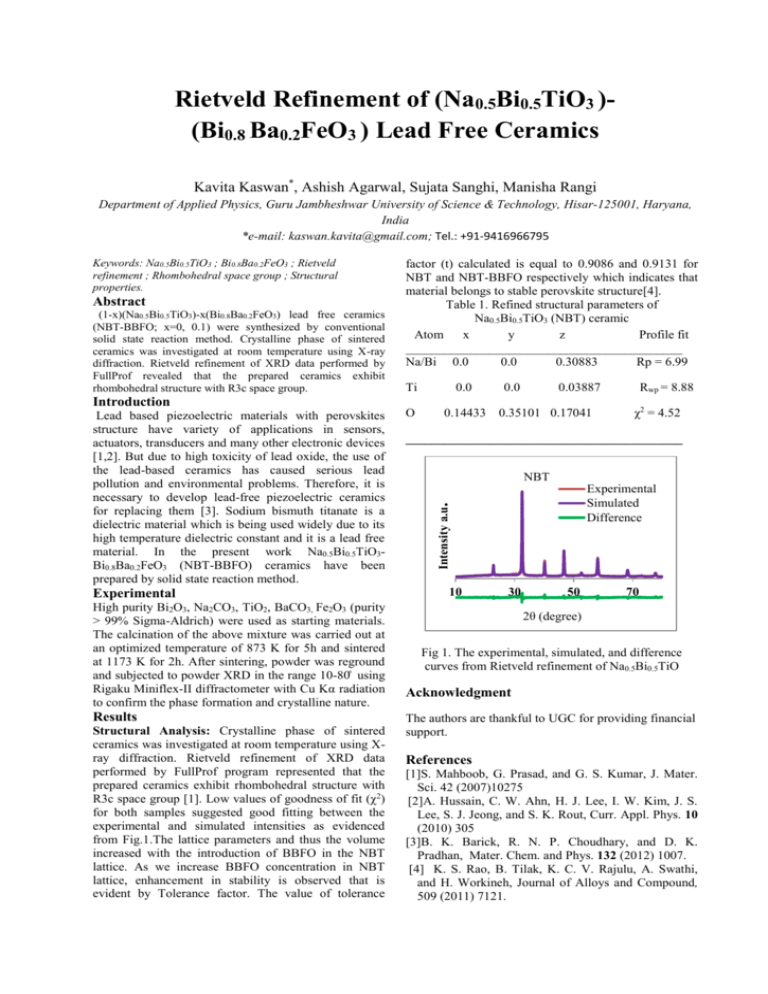
Rietveld Refinement of (Na0.5Bi0.5TiO3 )(Bi0.8 Ba0.2FeO3 ) Lead Free Ceramics Kavita Kaswan*, Ashish Agarwal, Sujata Sanghi, Manisha Rangi Department of Applied Physics, Guru Jambheshwar University of Science & Technology, Hisar-125001, Haryana, India *e-mail: kaswan.kavita@gmail.com; Tel.: +91-9416966795 Abstract (1-x)(Na0.5Bi0.5TiO3)-x(Bi0.8Ba0.2FeO3) lead free ceramics (NBT-BBFO; x=0, 0.1) were synthesized by conventional solid state reaction method. Crystalline phase of sintered ceramics was investigated at room temperature using X-ray diffraction. Rietveld refinement of XRD data performed by FullProf revealed that the prepared ceramics exhibit rhombohedral structure with R3c space group. Introduction Lead based piezoelectric materials with perovskites structure have variety of applications in sensors, actuators, transducers and many other electronic devices [1,2]. But due to high toxicity of lead oxide, the use of the lead-based ceramics has caused serious lead pollution and environmental problems. Therefore, it is necessary to develop lead-free piezoelectric ceramics for replacing them [3]. Sodium bismuth titanate is a dielectric material which is being used widely due to its high temperature dielectric constant and it is a lead free material. In the present work Na0.5Bi0.5TiO3Bi0.8Ba0.2FeO3 (NBT-BBFO) ceramics have been prepared by solid state reaction method. Experimental High purity Bi2O3, Na2CO3, TiO2, BaCO3, Fe2O3 (purity ˃ 99% Sigma-Aldrich) were used as starting materials. The calcination of the above mixture was carried out at an optimized temperature of 873 K for 5h and sintered at 1173 K for 2h. After sintering, powder was reground and subjected to powder XRD in the range 10-80̊ using Rigaku Miniflex-II diffractometer with Cu Kα radiation to confirm the phase formation and crystalline nature. Results Structural Analysis: Crystalline phase of sintered ceramics was investigated at room temperature using Xray diffraction. Rietveld refinement of XRD data performed by FullProf program represented that the prepared ceramics exhibit rhombohedral structure with R3c space group [1]. Low values of goodness of fit (χ 2) for both samples suggested good fitting between the experimental and simulated intensities as evidenced from Fig.1.The lattice parameters and thus the volume increased with the introduction of BBFO in the NBT lattice. As we increase BBFO concentration in NBT lattice, enhancement in stability is observed that is evident by Tolerance factor. The value of tolerance factor (t) calculated is equal to 0.9086 and 0.9131 for NBT and NBT-BBFO respectively which indicates that material belongs to stable perovskite structure[4]. Table 1. Refined structural parameters of Na0.5Bi0.5TiO3 (NBT) ceramic Atom x y z Profile fit ___________________________________________ Na/Bi 0.0 0.0 0.30883 Rp = 6.99 Ti 0.0 O 0.14433 0.0 0.03887 0.35101 0.17041 Rwp = 8.88 χ2 = 4.52 ___________________________________________ NBT Experimental Simulated Difference Intensity a.u. Keywords: Na0.5Bi0.5TiO3 ; Bi0.8Ba0.2FeO3 ; Rietveld refinement ; Rhombohedral space group ; Structural properties. 10 30 50 70 2θ (degree) Fig 1. The experimental, simulated, and difference curves from Rietveld refinement of Na0.5Bi0.5TiO Acknowledgment The authors are thankful to UGC for providing financial support. References [1]S. Mahboob, G. Prasad, and G. S. Kumar, J. Mater. Sci. 42 (2007)10275 [2]A. Hussain, C. W. Ahn, H. J. Lee, I. W. Kim, J. S. Lee, S. J. Jeong, and S. K. Rout, Curr. Appl. Phys. 10 (2010) 305 [3]B. K. Barick, R. N. P. Choudhary, and D. K. Pradhan, Mater. Chem. and Phys. 132 (2012) 1007. [4] K. S. Rao, B. Tilak, K. C. V. Rajulu, A. Swathi, and H. Workineh, Journal of Alloys and Compound, 509 (2011) 7121.

